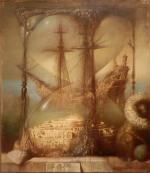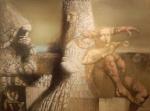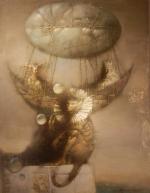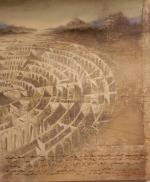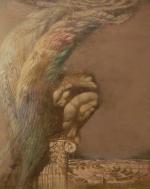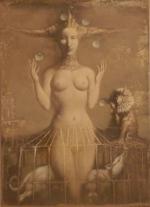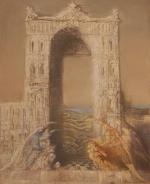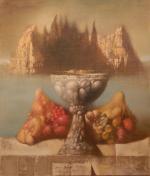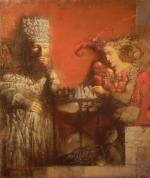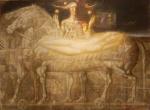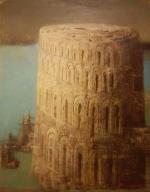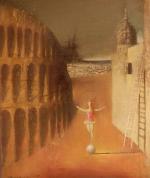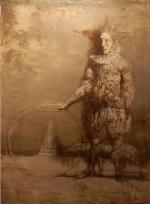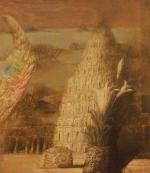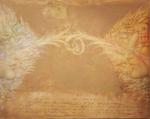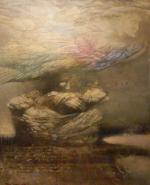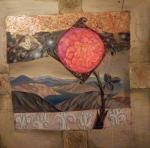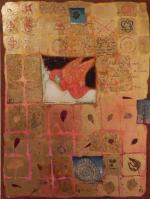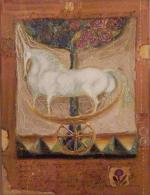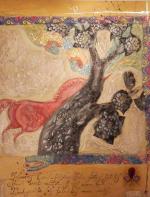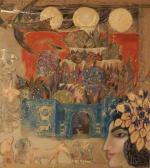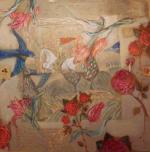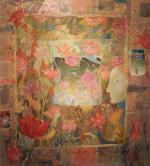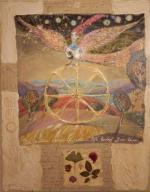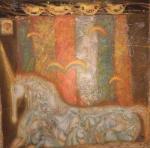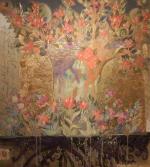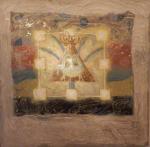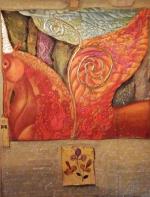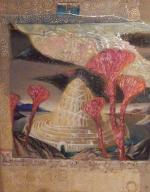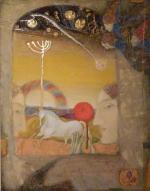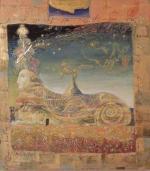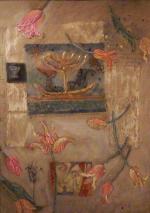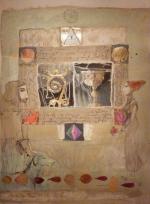Exhibition of November 2013
Armen Gasparyan
Olga Gasparyan (Syskova)
«The Head is Full of Sun»
Painting
04.10.2013 - 29.10.2013
The rule of the labyrinth.
(Paintings and drawings by Armen Gasparyan).
Labyrinth includes the ideas of the movement, mystery, transformation.
An attentive scrutiny of paintings and drawings by Saint-Petersburg artist Armen Gasparyan like wandering through a labyrinth - from painting to painting, from sheet to sheet, from image to image, on and on. And, at the same time, in the past: color of his paintings reminiscent of the "museum" painting, drawing - works by old masters, the images - are the days when beauty was still considered the prerogative of art. Kings, clowns, faces, masks, monkeys, birds, dogs, towers, shells, chameleons, plants and birds' nests, growing just out of the women's heads... By the will of the artist, they are experiencing a mysterious metamorphosis, woven into a whimsical dance fuse together, forming absolutely fantastic creatures. Is about to appear out - will be fully understood the meaning encountered in the way of images, symbols, allegories, signs, gestures. After all, many of them are well known by the classic examples of European art! But the artist not only repeats the known samples, but reminds them, gives them a different meaning, unites them in unexpected combinations. How dodgy mythical master Daedalus - the author of the Cretan labyrinth, he erects in the way of the spectator new turns, traps, obstacles that force to move slowly, feel and think.
It may be "they do but jest" as Shakespeare told? It is no accidently that in painting by Armen Gasparyan often appear the images of clowns, harlequins, and so persistently repeats motif of the game - the manipulation of objects, puppets, musical instruments, and finally, a game with a mask. But the mask is always reminds of secret's hiding and encourages to its unraveling.
Ancient hero Theseus helped to escape from the labyrinth the salvage thread of Ariadne. There is such a thread in the paintings of Armen Gasparyan also, but it often turns out to be eerily tangled. Fingers of men and women in the picture "Game with threads". The girl in the picture "Veil" looks like a movie heroine of S.Paradzhanov, through the threads woven lace. Tackle are stretched by thin threads in the "Ship of Fools ". The cages of" Birders "are hanging on the threads. Women's jewelry and headdresses of painting and graphic characters seem as wicker - the thread. And the drawing itself - is actually a very accurate and strong, deliberately complicated by" threads "of additional, as if random strokes and drips of paint. In addition, the graphics and canvases often includes ligature of incomprehensible, unreadable text, which is also seen as a confusing of threadlike lines. In these metaphors - a key (not to unravel the mystery, but only to the wording of) one of the main themes of painting by Armen Gasparyan: man is not free, is entangled by set of real and imaginary problems, captivated by his own delusions and passions. The motif of captivity in some paintings depicting by image of a glass ball, cages or rings in which the birds are sitting, by fingers spread, through which, as through the bars, look at the world the heroes and heroines. Characters of paintings by Gasparyan - are also prisoners of the labyrinth. And often - as it happens in life, are not aware of this: they melancholically sad, pensive smile or, having closed eyes, escape from life's storms in dreams and reveries.
The famous Cretan labyrinth conceal a monstrous creature - a man with a bull's head - the Minotaur. Among the works by Armen Gasparyan there is also "Minotaur." He is the center of symbolic labyrinth, built by the artist, because the main idea of ??his art - the mysterious nature of man, which combines the qualities of animal and deity, the low, natural and high, spiritually enlightened.
Connection of incompatible qualities in one being - is an old idea. Since antiquity it was embodied in the images of centaurs, fauns, Minotaur, Chimera. But the harmony of poles of human nature - the problem is unsolvable, and therefore always up to date.
Armen Gasparyan's compositions of paintings, objects, details at different levels embody the idea of ??motion: in fast swirling spirals of the towers, shells, constellations, in flowing like by wind women's curls, hand gestures of characters, in their transformations. The idea of ??movement, transition, overcoming embody also strange characters - people on stilts (or one person depicted in various stages of motion), resembling spider-like legged elephants in surreal visions of Salvador Dali.
The metaphor of movement and plot, inspired by the well-known legend of St. Christopher - "Carrier of Christ (in Greek)". For A. Gasparyan main point of the story - the idea of ??human life as a way, transition from shore to shore, from birth to death. His Christopher - an old wanderer, tightly clutching the staff by hands and as if not feeling on the shoulders the severity of the precious burden. Around - the river, in the distance, like a hallucination, a tower-labyrinth, ahead - a light, to which he aspires. The light that promises an exit and salvation.
In many paintings of A. Gasparyan presents active red color. The color of life, of beauty, but also the color of sacrifice blood, suffering. It will recall to many people also about the famous monument of antiquity - the paintings of Villa of Mysteries related to the sacraments of initiation. The association is not coincidental.
It is believed that the passage of the labyrinth in ancient cultures was associated with the rite of initiation - initiation into the mysteries of Man, Earth and Space.
After passing the labyrinth, nobody can remains the same again - newfound knowledge transforms the person. As well as communication with artwork.
And rule of passing through labyrinth is simple: to go forward, do not rush, do not look back. Those who hurry up to get out of the labyrinth slows their haste itself, and people striving for goal, but away from it, considered the Roman philosopher Seneca.
Art critic Irina Mamonova
Her works are resemble at the same time the icon and a page of the medieval Code. By iconography back gold and red backgrounds, which were conceived as the presence of the Divine light, placement the main meaning images in the center square - "ark", minor ones - in the margins. Latin texts originated from European medieval miniature, so as an abundance of plant and flower ornament filling the space of paintings. Latin texts in her works are always readable - it's not just decorative ligature - they often included the key to the meaning of the image.
Olga's works always retain a sense of handwork. This is not the painting in the traditional sense: many parts are relief and resemble metal engraved or etched surfaces of iconic frames or utensils, canvas sometimes covered with texture, which is associated with the surface of the old stone or stucco, ornament likened embroidery or printing on fabric.
In special stamps on the surface of the canvas glued dried flowers, leaves, herbs, harvested in different countries while traveling and commuting. This is something from a children's game "in surprises," or from a personal diary, full of cherished memories, ruled by "the all-powerful god of details, all-powerful god of love."
Art critic Irina Mamonova
